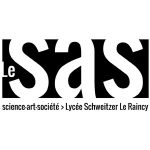L'Air du Pollen
The aim of this project is to bring the public closer to pollen grains that are almost invisible to the naked eye, to understand their diversity, their vulnerability and their future.
Project
This project on biodiversity offers a poetic immersion in the invisible and inaccessible universe of pollens
Productions
An interactive, visual and sound installation of 30 pollen grains suspended in the air and a participatory mediation course
Partners
2 artistic companies, as well as 4 scientists and artists are brought together in this project supported by the Carasso Foundation
Project
With lightness and depth, L’Air du pollen deals with the unprecedented decline in biodiversity: about a million animal and plant species are threatened with extinction at a rate 100 to 1,000 times the natural rate of extinction. Pollen is a sensitive marker of these global imbalances. Loss and degradation of habitats, overexploitation, pollution and global warming are all pressures induced or accentuated by human activities that lead to a different selection of functions and therefore of platform structures, reducing biodiversity and the future capacity of plants to adapt to change.
The Air of Pollen takes a quirky and original approach to the problem by revealing the heart of the incredible and precious biodiversity of plants. At a turning point in our society, where the erosion of biodiversity is a major problem, a better appropriation of this issue, but also an amazement for this biodiversity is vital. To observe and understand this microscopic diversity is to touch the mystery of creation. With 30 grains of pollen suspended in the air, Air du pollen offers an immersive and interactive walk through the heart of biodiversity.


The pollen grains impose both their presence through the weight of the material, the stoneware that constitutes them, and their fragility through the fictitious weightlessness of their suspension. In this search for contrast and excitement, L’Air du pollen combines one of the oldest techniques, ceramic art, with the cutting edge technology of digital art, living art. It discreetly mixes wandering, contemplation and interaction, action. It allows reflection and awareness of the fragility of this microscopic biodiversity.
To accompany this contemplation, the project also offers participative mediation around the work. In collaboration with a network of schools and in a transdisciplinary approach, the Transplanisphere will conduct mediation workshops with students from kindergarten to high school. Together, they will design a learning path adapted to each school level and prepare a mediation campaign associated with the diffusion of the work.
Productions
Magnified, shaped, sculpted, heated, thirty ceramic pollen grains are suspended in balance in the air. Experienced in a sound landscape, while the air blows and the images they capture are projected, they allow us to apprehend a simple or complex beauty destined to the production of life.
Thus, curious passers-by discover these grains, raw and structured in the daylight, textured and enriched at nightfall. Thanks to an invisible suspension system, they are hung high on a structure indoors or on a tree outdoors. Outside or inside, they invite passers-by on an immersive walk.
Each pollen grain tells a story. Its own, a little of our own.
Design of ceramic pollens
The pollens will be modelled in white chamotte sandstone; this natural sandstone is produced in France. They will be displayed unglazed, without glaze or colouring. The material used to make them comes from the CESFO (Comité d’Entraide de la Faculté d’Orsay) plastic arts workshops.
Digital walk
This walk is composed of interactive visual and sound projections. Solar panels accompany the installation in order to accumulate energy outdoors, which will allow the work to function minimally at night. The video projection will then be replaced by LED lighting animated by the visitors’ steps.
Participatory mediation
The Transplanisphere brings together a community of schools to design a knowledge trail around the work, which will be installed in the park of the Schweitzer high school. The company will lead this mediation with the scientists, artists, teachers and students involved in the project.
Project agenda
The first year of the project will see the production of ceramic pollens to fully account for the morphological biodiversity of pollens.
The materials and the scenography of their exhibition will be designed and produced at sas>201, Orsay. The visual and sound landscapes will be composed and tested in parallel.
Workshops and interventions will be co-designed at the high school with students and teachers. The first public presentation will take place at the Université Paris Saclay.
The second presentation of L'Air du pollen will take place outdoors at the Domaine de Chamarande, then the work will be exhibited at the Lycée Schweitzer in Raincy.
Two other outdoor presentations of L'Air du pollen will be organised at the Muséum d'Histoire Naturelle and the Domaine de Chaumont-sur-Loire.
Partners
The project is led by :
- The sas (Science-Art-Society group at the University of Paris-Saclay)
- Béatrice Albert: teacher-researcher.
- Nadia de Bernardi: visual producer.
- Ikse Maître: Set designer.
- Vincent Hulot: soundscape composer.
- La Transplanisphère from Paris.
L’Air du pollen is a creation of Vues de l’esprit; an opening of the sas, a science-art-society group and Transplanisphère; a production of La métonymie, in collaboration with the ESE and BioMaps, in partnership with the CNRS and the University of Paris-Saclay and with the support of the IDEEV and the Carasso Foundation.





